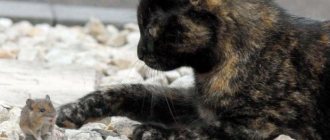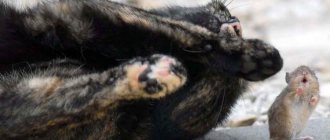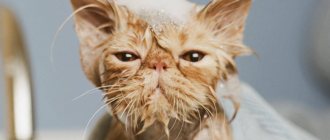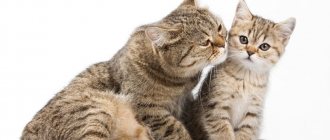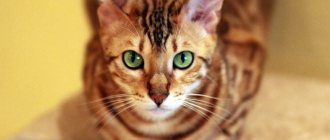Why cats don't eat rats
Rats still bring more horror to ordinary people than tenderness, as in the Indian temple of Karni Mata, where it is considered a special favor when a rat runs over your legs.
I know this from personal experience. In the early seventies, I had to live in an old barracks near the old River Station of the city, where the gigantic construction of a new auto giant had just begun.
But in the old areas of the old city everything went on as before: with rats and infections, large garbage dumps and dirt. That’s when I first became closely acquainted with rats and their evil disposition.
Since the old barracks stood on the banks of the Kama, the foundation was high in case of spring floods. Accordingly, the basement was large. There, in freedom and abundance, lived these ominous creatures - rats.
At night it was impossible to sleep from the crunching of rats’ teeth, which were constantly gnawing and eating something. And no matter how they were chased away, no matter how the holes were not sealed, they appeared again and again: because nearby there was a garbage dump in which the rats were constantly swarming, looking for food.
Rats in the Indian temple of Karni Mata
In the house next to ours there lived a woman with a little girl. One day, with horror in her eyes and voice, she told how her daughter screamed at night. When she turned on the light, she saw a huge rat jumping off her daughter’s crib. The girl screamed in pain - the rat sank its teeth into her finger and almost bit through it.
But this is just an introduction to what I want to talk about further. The horror that I experienced then cannot be compared with what the Leningraders experienced during the siege. I wanted to post this material before Victory Day, but I didn’t have the strength. And now, although belatedly, I am still posting stories and diary entries of eyewitnesses about the horrors of the Leningrad Siege.
Rats in the Indian temple of Karni Mata
I give only selective passages that seem to me to be the most accurate stories about what was happening in the city in those days. And it seems to me that these close and small details of life in those years speak more about the horrors of war than giant canvases about battles from a bird’s eye view.
“In 1942, besieged Leningrad was overcome by rats. Eyewitnesses recall that rodents moved around the city in huge colonies. When they crossed the road, even the trams were forced to stop.
They fought against rats: they were shot, crushed by tanks, even special teams were created to exterminate rodents, but they could not cope with the scourge. The gray creatures devoured even those crumbs of food that remained in the city.
In addition, due to the hordes of rats in the city, there was a threat of epidemics. But no “human” methods of rodent control helped. And cats - the rats' main enemies - have not been in the city for a long time. They were eaten. No excuses were needed: a cat's dinner was often the only way to save life.
“December 3, 1941. Today we ate fried cat. Very tasty,” a 10-year-old boy wrote in his diary. “We ate the neighbor’s cat with the entire communal apartment at the beginning of the blockade,” says Zoya Kornilieva.
“It got to the point in our family that my uncle demanded Maxim’s cat to be eaten almost every day. When my mother and I left home, we locked Maxim in a small room. We also had a parrot named Jacques.
In good times, our Jaconya sang and talked. And then he got all skinny from hunger and became quiet. The few sunflower seeds that we exchanged for daddy’s gun soon ran out, and our Jacques was doomed. The cat Maxim also barely wandered - his fur came out in clumps, his claws could not be removed, he even stopped meowing, begging for food.
One day Max managed to get into Jacone's cage. At any other time there would have been drama. And this is what we saw when we returned home! The bird and the cat were sleeping in a cold room, huddled together. This had such an effect on my uncle that he stopped trying to kill the cat...”
In the spring of 1942, an old woman, half dead from hunger, took her cat outside for a walk. People came up to her and thanked her for saving it. One former blockade survivor recalled that in March 1942 she suddenly saw a skinny cat on a city street. Several old women stood around her and crossed themselves, and an emaciated, skeletal policeman made sure that no one caught the animal.
In April 1942, a 12-year-old girl, walking past the Barrikada cinema, saw a crowd of people at the window of one of the houses. They marveled at an extraordinary sight: a tabby cat with three kittens was lying on a brightly lit windowsill. “When I saw her, I realized that we had survived,” this woman recalled many years later.
But let's get back to the rats. In her diary, blockade survivor Kira Loginova recalled, “Darkness of rats in long ranks, led by their leaders, moved along the Shlisselburg tract (now Obukhov Defense Avenue) straight to the mill, where they ground flour for the whole city. This was an organized, intelligent and cruel enemy. "
All types of weapons, bombings and fires were powerless to destroy the “fifth column”, which was eating up the blockade survivors who were dying of hunger. In 1943, it was decided to bring cats to Leningrad. A resolution was issued signed by the chairman of the Leningrad City Council on the need to “extract smoky cats from the Yaroslavl region and deliver them to Leningrad.”
The Yaroslavl residents could not help but fulfill the strategic order and caught the required number of smoky cats, which were then considered the best rat catchers. Four carriages of cats arrived in a dilapidated city. Some of the cats were released right there at the station, and some were distributed to residents.
Eyewitnesses say that when the meowing rat catchers were brought in, you had to stand in line to get the cat. They were snapped up instantly, and many didn’t have enough. In January 1944, a kitten in Leningrad cost 500 rubles (a kilogram of bread was then sold secondhand for 50 rubles, a watchman’s salary was 120 rubles).
The cats who arrived in the dilapidated city, at the cost of great losses on their part, managed to drive away the rats from food warehouses.
As soon as the blockade was lifted, another “cat mobilization” took place. This time, murks and leopards were recruited in Siberia specifically for the needs of the Hermitage and other Leningrad palaces and museums. The “cat call” was a success.
In Tyumen, for example, 238 cats and cats aged from six months to 5 years were collected. Many brought their pets to the collection point themselves. The first of the volunteers was the black and white cat Amur, whom the owner personally surrendered with the wishes of “contributing to the fight against the hated enemy.”
In total, five thousand Omsk, Tyumen, and Irkutsk cats were sent to Leningrad, who coped with their task with honor - clearing the Hermitage of rodents.”
Popular questions:
If a mouse ate poison and a cat ate a poisoned mouse, is it dangerous for her?
In most cases, nothing bad will happen to the cat, since the mouse is small in size and the concentration of poison will not be high.
For a cat to get poisoned from a mouse, it needs to eat several mice at the same time. Poisons containing rodenticides are dangerous for cats. It can have a fairly strong toxic effect on the animal, even in minimal quantities. If you see that your cat is sick, not feeling well, and you understand that she could have caught and eaten a poisoned rodent, take her to the vet. If there are mice and cats in the house, do not use poison to kill rodents, but use mechanical traps.
You may like: Can cats be given milk?
What is the effect of using peppermint against mice, and is it safe for a cat?
Some people use peppermint essential oil to repel rodents and prevent cats from preying on them.
In recent years, some experts have expressed concern that essential oils have toxic effects on cats. Unfortunately, I couldn’t find any research on this topic, so decide for yourself. In any case, the effectiveness of this method of controlling rodents is questionable, since essential oils quickly evaporate and cease to be effective.
Are ultrasonic mouse repellers safe for cats?
In 99% of cases they are safe and cats do not pay attention to them, although after a while rodents also get used to them and stop being afraid.
If you decide to use them, just pay attention to the behavior of your pet; if he does not react to them in any way, then use them calmly.
Can a cat become infected with something from eating a mouse?
Yes, maybe the main danger is associated with parasites.
Mice can be infected with the parasite Toxoplasma gondii, as a result of which the cat can get toxoplasmosis and infect the owner and all members of his family with it. In addition to mice, this disease is also spread by some birds, such as pigeons, which cats can also hunt. At the same time, it is quite difficult to destroy the causative agent of toxoplasmosis, the treatment is complex and lengthy, and in most cases you will have to live with it for the rest of your life. Cats infected with toxoplasmosis often show no symptoms. Sometimes they may have lethargy, gastrointestinal problems or even breathing problems. But in most cases, cats will silently carry and spread this pathogen throughout their lives.
In addition to toxoplasmosis, mice can carry other intestinal parasites that easily infect pets and people.
You may like: What to do if my cat won't drink water
Some rodents carry the bacterium Yersinia pestis, or simply put, plague. These are the same bacteria that caused big problems for humanity during the Middle Ages. Plague is usually spread by fleas, but cats can easily become infected by eating the meat of infected animals.
Symptoms of an animal infection include lethargy, depression, loss of appetite, vomiting, diarrhea, cough, muscle soreness and fever. The lymph nodes become enlarged, the mouth is affected and weight loss occurs.
People rarely become infected with distemper transmitted by cats; in most cases it occurs from a flea bite, the symptoms are similar to those in a cat.
Rodents carry leptospirosis, it is rarely found in cats, however, they can become infected with it and transmit it to humans; people are very susceptible to this pathogen. Leads to liver disease in dogs and humans.
Rodents carry hantavirus infections; cats can easily become infected with it, asymptomatically, and in most cases this virus is not dangerous for them. There are no known cases of hantavirus transmission from cats to humans, but it is easily transmitted to humans from rodents, and can cause quite serious consequences. A well-known hantavirus that many hunters and tourists encounter is the so-called mouse fever. It can be contracted by spending the night in taiga huts, where mouse droppings turn into dust and enter the lungs.
The fun process of catching rodents
This cute, fluffy, affectionate creature is a natural enemy of field mice, house mice, and rats. Pests cannot even stand the smell of cats; they avoid their property and fear for their lives.
In cats, the huntress instinct is genetically embedded. Even when well-fed, she will not miss the moment to chase a mouse that suddenly appears. The process itself gives pleasure - to catch, not to miss. But whether to kill, eat or not depends on other factors.
A study was conducted in the USA. They crossed purebred cats and yard cats with one cat. The kittens were swapped after they were born. Purebred cats were raised by yard cats. As a result, it turned out that everyone had developed hunting skills. Mothers regularly brought small rodents to their kittens. But further actions were different. The yard worker killed in cold blood, showed how it should be done to the kittens, and gave them to them to eat. The thoroughbred was limited to playing. The conclusion followed was that in order for kittens to start catching mice and eating them, an example is needed. Instinct alone is not enough; skills are also required.
Why do cats always torture their prey?
Contents hide
Why do cats always torture their prey?
Do you think they are so infinitely cute, our cats and cats? Have you seen any furry pets while hunting? How a meek, respectable cat, who loves to purr so much at your feet, selflessly torments a mouse that has just been caught! And it would be okay to just kill him - but he also shows pronounced “sadistic” inclinations. What kind of instincts do cats have? Let's try to figure it out.
The prey must be “weared down.” Perhaps we will now surprise some of our readers: your quiet beloved cat is a real beast of prey. With all the ensuing consequences. And if a predator means a born hunter. It is not a fact that cats can hunt exclusively for mice or birds, that is, exclusively for small victims. Some cats choose victims much larger than themselves, and use a “unique” strategy. It is called “starve out.” The cat will exhaust its potential prey and deprive it of its strength. Then at the decisive moment he will strike, that is, throw. It will end with a fatal bite - cats prefer to sever the spinal cord of their victim. However, the tailed animals do not deny themselves the pleasure of playing “cat and mouse” with any victim.
Predatory instincts. You've probably watched exciting stories on TV shows dedicated to the lives of animals. Look: lions, jaguars, pumas, leopards and... domestic cats. And these animals hunt in approximately the same way, they have the same favorite techniques, with rare exceptions. Which tells us one thing: you have sheltered a real predator in your home!
“Mom will teach you.” How does a kitten recognize itself as a predator? How does he become a hunter? Some models of “hunting” behavior are laid down at the level of instincts. The fact is undeniable. But most of the kitten’s tricks and tricks are taught by the mother cat. What do those who need a pet rat-catcher usually do? They are looking for a corresponding ad: “Kitten from a rat-catcher mom.” What does it mean? Mom taught her kittens everything: she caught a rodent, strangled it to be sure, and brought it to her kittens. And using a “living visual aid” she told the kids how to catch, how to kill, and what is needed for this. That is, the kittens have acquired the necessary necessary experience! And there is no doubt that the rodents in your dacha will have a very hard time.
Lessons take place in several stages. Lesson one - “general acquaintance with the rodent.” The mother brings in a mouse or rat and kills it in front of the kittens. Lesson two – “introduction to hunting.” Kittens also take part in the hunting festival and acquire their first “killer” skills. Lesson three – “repetition of what has been learned.” Mom brings a dead or barely alive rat, throws it to the kittens - and then they do it themselves! As a rule, kittens finish off the prey and eat it. Subsequent lessons can be expanded and supplemented according to the diligence and abilities of the students. The overall result is the same - the world is getting five new rodent exterminators, calculating and ruthless. Kittens learn different hunting and “killing” techniques gradually, step by step. They go hunting first with their mother, and then take independent forays.
“Learn while playing!” The principle is excellent, it works flawlessly. Watch little kittens play in a box. Ambushes, throws, grabs - all these skills are honed through the game.
Uncertainty and uncertainty. I recently saw a funny video on the Internet about how a cunning mouse managed to convince a cat tormentor of his own death. The huntress made a major mistake in her work - she was not convinced that the job was done one hundred percent, the victim was dead. Carefree cat! That mouse, of course, escaped. What if in her place there was another, much more dangerous beast? He could well have attacked on the sly, and it is unknown how the fight would have ended. Smart cats always “torture” their victims, trying to double-check themselves dozens of times: are there really no “ambushes”? A kind of cat self-defense and safety net!
How about enjoying it? You live in a comfortable city apartment, where you have never seen rodents. How will your pet behave? The answer is - you buy him toys, the same mice. And he “torments” and “tortures” them in the same way! But: if a “village” cat gets food for itself, then a “city” cat hunts for fun! Such a cat does not have an innate desire to kill prey - and she does not even know what it is. But the instincts we talked about above work! Mother Nature did her best here too, instilling in her children the instincts of hunting and survival. Who knows?!
Now let's summarize. The mouse is caught and guaranteed to be killed. What will the cat do? If she obtains food in this way, the victim will be immediately eaten. Is the hunt being conducted “for the sake of order”? Such a cat will carefully place the mice on the threshold of the house - look, master, I’m earning my living!
And what about the pampered city darling? She also loves mice. Stuffed, groovy... whatever you buy for her. Just like that, have fun and play!
Photo: pixabay.com
Reasons for eating rodents
When asked why cats eat mice, the answer always arises - because of hunger. The situation when a skinny cat sees a dead rodent and is in no hurry to touch it has dispelled this myth. Then why does the cat eat the mouse?
Nature has established an inextricable connection between cats and rodents. Mouse skin contains many useful trace elements, especially sulfur. They are necessary for the full development of the cat’s body and good health. Sulfur is a component of cystine and mythionine. The components are responsible for the health, beautiful coat, and mood of the cat. Meat should be included in the daily diet. In its absence, pets begin to get their own food.
Indoor cats will not chew mice, since their supply of sulfur comes with vitamins, which the owner constantly supplies them with. There is no feeling of hunger and access to food is unlimited. Therefore, you can see a cat eating a mouse on the street among the yard “residents”.
Will cats help?
Cats will help solve the problem of the increasing number of rats in the city, some Magadan residents are sure. Users expressed their opinions here and here.
History confirms the successful use of cats to solve this problem.
The most striking example is besieged Leningrad. Before the war, cats, unnoticed by others, performed an important function day after day - they controlled the rat population. During the blockade, the number of animals in the city was reduced to zero, both domestic and street. But more and more rats appeared on the city streets. In January 1943, the blockade was broken. Realizing the scale of the catastrophe caused by rats in the city, the military command ordered “four carriages of smoky cats to be ordered and delivered to Leningrad.” The choice fell on Yaroslavl, where smoky cats, considered the best rat catchers, were found in abundance.
Four carriages turned out to be not enough; in addition, there were so many rats that they gave their natural enemies a serious rebuff. Often, cats became victims in fights. The blockade was completely lifted only at the end of January 1944. Then another batch of cats was sent to Leningrad, which this time were recruited in Siberia, mainly in Irkutsk, Omsk and Tyumen.
In memory of what cats did for the city, in 2000 in St. Petersburg, a sculpture of the cat Elisha was installed on house No. 8 on Malaya Sadovaya, and on the contrary, on house No. 3, a sculpture of his friend, the cat Vasilisa, reports Reedus.
Cats still protect the country's cultural heritage from rodents in the Hermitage.
The following breeds are recognized as the best rat catchers: Siberian cat, Maine Coon, Kurilian Bobtail, European Shorthair, Cymric, British Shorthair, Russian Blue.
Disadvantages of eating rodents
Can a cat eat mice? It sounds strange. These are two components of one chain. Cats should eat rodents in the wild, live indoors, but be outdoors frequently. In modern conditions, there are several risks from which pets should be protected.
- Cats should not be allowed to eat mice if there is a risk of poisoning. If neighbors use poison to control rodents, the cat receives a dose of mouse poison.
- The hunter should regularly receive medications against helminths, fleas, and ticks. Rodents are the main distributors of parasites. The pet must be protected.
- All routine vaccinations are required. Mice spread many terrible diseases. Some of them are transmitted to humans through pets after contact with a mouse.
A cat brings prey into the house for several reasons - to brag about its achievement to its owners, to “feed” them, to hide them from barn cats, to eat them later, as a reserve for a rainy day.
Cats eat mice, but not all of them. This requires not only hunting instincts, but also certain living conditions. Yard kittens are capable of conducting the most brutal hunt for rodents already at 5 months of age.
Does a cat eat mice?
If a pet's diet is balanced, and it receives the substances necessary for the normal functioning of the body with food, then it is unlikely that it will eat rodents. A normal healthy cat will not refuse to catch mice, but hunting will turn into entertainment for him. Many fanciers are faced with a situation where a cat brings prey into the house, displays it in a visible place, bragging about its achievements to the owner. Another option is also possible: the animal hides, say, rats with their heads chewed off, in a secluded corner, under the carpet. An unpleasant smell, coming from nowhere, makes it possible to detect a “storeroom”, and this is a problem that needs to be solved.
Why do cats eat mice?
Hunting and eating tailed rodents is not only satisfying the hunting instinct, but also maintaining the cat’s health, which he is trying to ensure for himself at a natural level. The fact is that the brain of mice contains a large amount of taurine, which is vital for cats. This substance plays a huge role for the animal:
- regulates the operation of the central system;
- forms strong immunity;
- normalizes the process of blood clotting, preventing the opening of internal bleeding and promoting rapid healing of wounds;
- maintains the functioning of the reproductive system at the proper level;
- is a strong antioxidant that cleanses the body;
- facilitates contraction of the heart muscle, replenishing the necessary calcium concentration.
If the level of taurine in the body drops as a result of insufficient intake from food, the animal may develop heart and vascular diseases, as well as neurological disorders. When a cat suddenly starts catching and eating mice, this is a signal for its owner that it is necessary to reconsider its diet and introduce foods enriched with taurine into the diet.
Other elements necessary for a cat - sulfonic acids, which include methionine, cystine and cysteine, are found in mouse skin. These sulfonic acids are necessary to maintain the normal condition and thickness of the cat's coat. If a cat eats a mouse along with its skin and fur, it means that it is experiencing a shortage of these elements.
Cats, mice and wildlife
Small mouse-like rodents are the basis of the diet of cats from the genus Felis, including the African steppe cat (Felis s. lybica), the wild ancestor of our pets.
But everything is a little more complicated than “the cat eats the mouse, the mouse eats the grains.”
What does a cat eat
Mouse-like rodents are not one species or even one genus. The collective name hides two large families: Mouse (Muridae) and Hamster (Cricetidae). The latter, in addition to the hamsters themselves, include voles.
Although when compiling a natural diet for cats we focus on the nutrient composition of a typical mouse, the house mouse (Mus musculus), this is still a convention. The actual diet of wild cats is much more diverse due to different types of rodents, not to mention other small mammals, birds, reptiles and invertebrates.
Fact: In nature, cats eat many types of rodents. Along with the contents of their stomach... or not?
Not always. A hungry cat does not waste time cutting up the mouse and actually eats the whole carcass, but after a successful hunt it can leave the stomach, intestines and gall bladder, or even eat only the head, the receptacle of the fatty nutritious brain. Similar behavior has been described in others, including large representatives of the cat family. Far Eastern leopards, for example, first of all eat the liver (liver, but not the stomach and intestines) and meat from the thighs from hunted deer. They are not interested in the stomach.
That is, not every prey ends up in the cat along with its stomach.
What's in a mouse's stomach?
Grains and seeds are the main, but not the only component of the diet of mouse-like rodents. Their diet is very diverse and includes not only plant (herbs, roots, bark, nuts, seeds, berries, mushrooms), but also animal components (small invertebrates, carrion).
Interesting
On Gough Island, house mice are an invasive species that are pushing the rare albatrosses to the brink of extinction. Mice actively eat eggs and even fairly large live chicks.
It is worth noting that in nature, rodents feed mainly on the seeds of wild plants, and not on cultivated grains. And in the diet of, for example, the wood mouse (Apodemus sylvaticus), acorns play an important role. Based on this, should you feed your cat wild grass seeds and acorns?
Given such a varied diet, catching a mouse with grains in its stomach becomes a difficult task for a cat. But, let’s say, the cat still gets a certain amount of “grain” mice.
The most interesting thing here is the size of the stomach. A simple experiment shows that the stomach of a laboratory mouse, together with its contents, makes up no more than 4% of the weight of the mouse itself, that is, less than a gram. The average weight of an adult mouse is 20 grams.
Taking into account the fact that the cat eats not only mice, it does not always eat them with its stomach, and the mice are not always well-fed, then the total content of fermented grains in the cat’s natural diet is negligible - no more than 1%.
Moreover, porridge is not even a close analogue of the contents of a mouse’s stomach. The fermentation of crushed seeds with saliva and gastric juice at the chemical level is fundamentally different from the cooking of ready-made flakes. The seeds not only get wet and warm, they are also actively affected by the mouse’s digestive enzymes. The resulting mixture resembles porridge very vaguely. With the same success, one can consider half-digested meat in a cat’s stomach to be an analogue of a cutlet.
As you can see, the argument “the cat needs porridge because its natural prey eats grains” is completely unviable.
Satisfying the hunting instinct
Even the cutest and fluffiest kitten once played the role of a hunter and predator in nature. After people domesticated cats and began using them as pets, they no longer needed to hunt for food. However, instinct periodically takes over and requires its manifestation in domesticated conditions.
Even if a cat’s body does not lack any elements to maintain health, hunting for mice is its natural need, a reflex that cannot be restrained. Catching mice is not just the job of barn cats. Many purebred kittens living in greenhouse conditions, once they see a mouse, will definitely chase it. But whether they eat their prey for lunch or not depends on whether they are tormented by hunger.
Unhealthy food
Cat owners, especially people living in private properties and houses, rejoice when their pets start hunting for mice - pests of the household, and do not find anything wrong with the fact that the hunter decided to feast on his trophy. On the one hand, eating mice is natural for cats, on the other hand, such a lunch or dinner can turn into a huge problem for the animal, and often for the owner himself.
Why cats are bad at catching rats
Your pet is, although small, but a real predator with an indestructible hunting instinct embedded in its genes. At home, a cat has no real enemies or prey, so it can hunt moving objects (sometimes these can be your legs). A running vacuum cleaner or even a blender can also become an enemy. But if a cat walks on the street, then mice, birds and, probably, rats can become its prey. But is this really so?
Cats and rat hunting It turns out that cats are not very good at hunting rats. According to recent research, domestic cats have “contributed” to the extinction of a large number of small vertebrates, but rats are not one of them.
A team of researchers from Fordham University spent five months observing a colony of rats at a Brooklyn recycling center. They noticed an interesting interaction between cats and rats. Over the course of two months, the cats made only three attempts to attack the rats, killing only two. The attack on these two rats was carried out from an ambush, while the pursuit of the third was unsuccessful.
The thing is that rats are very large rodents. You've probably seen rats behind trash cans in the city - sometimes they look larger than dwarf dogs. The weight of a brown or gray rat can reach 330 grams, which is almost 10 times the weight of a mouse or small bird. An adult rat is a very unpleasant and even disgusting prey for a cat. If a cat has a choice, it will choose less impressive prey.
However, if there is a large population of street cats nearby, rats behave very carefully and prudently, trying not to come into the cats’ field of vision. If there are not very many stray cats nearby, then their relationship with rats becomes almost friendly - they even eat from the same trash cans. In any case, both rats and cats try to avoid open conflicts.
These studies contradict the prevailing belief that cats are excellent hunters of any prey and are excellent at catching rats. Also, research data suggests that artificially increasing the population of stray cats will not be the best way to get rid of the huge number of rats in large cities. The ideal option is to reduce the number of garbage cans and timely disposal of waste. Garbage attracts rats, and if it disappears somewhere, so will the rats.
Hunting at home Even if your pet sometimes walks outside, if possible, do not allow it to hunt small rodents and birds. Firstly, while hunting, a cat can accidentally get injured or be bitten by a rodent. Secondly, small rodents, including rats, are carriers of toxoplasmosis. Toxoplasmosis is a dangerous disease caused by parasites. If a cat eats a sick rodent, it can become infected. The disease is also dangerous for humans. Additionally, it should be regularly treated for ticks and fleas and vaccinated according to the recommendations of a veterinarian.
To prevent hunting of rodents and birds, walk your pet only on a leash and in a harness - hunting will become at least uncomfortable. With proper training, the cat will quickly get used to such walks. Buy toys for your pet - soft mice, birds and feathers are sold at any pet store. If you spend time with your cat every day and play with her, then her hunting instinct will be completely satisfied.
Safety regulations
If your pet lives in a private house where there are mice, and the likelihood of eating rodents is high, certain safety rules must be followed. First of all, this concerns vaccinating your pet against various infectious diseases transmitted by rodents. Vaccination should not be a one-time event. To protect your cat, it is important to follow the vaccination schedule and regularly take your animal for vaccinations.
The second safety rule concerns the use of various chemical agents to combat mice. Eating poisoned mouse meat, as already indicated, can result in severe poisoning and death for the cat.
If a cat actively demonstrates its hunting instinct towards rodents, it is prohibited to use poison with heavy chemical components. It's better to set mousetraps. They may not be as effective as spilled poison, but with mousetraps you don’t have to worry about the health and life of your pet.
Why did cats disappear from the streets?
If in besieged Leningrad animals disappeared for an obvious reason - hunger, then why did cats and cats begin to disappear from the streets in modern cities of the country?
The main reason for the reduction in the number of stray cats is considered to be the closure of basements of residential buildings. In 2003, the State Construction Committee adopted the “Rules and Standards for the Operation of Housing Stock,” which, among other things, limited the entry of animals into the basements of residential buildings.
Management companies have tightly closed the basements of the houses. Some sources claim that in this way some of the cats were walled up alive. Those cats that remained outside could not survive the winter. A quarantine was declared in a number of cities because, due to the inability of cats to enter the basement, rats had bred there, Gazeta Izvestia reports. Animal welfare movements have raised this issue.
The document has been finalized for a long time. In 2018, the Rules were finally adjusted. The Ministry of Construction took the side of stray cats, allowing at least one open vent with a cell size of 15 by 15 cm to be left in the basements of high-rise buildings. This follows from the revised text of the draft order of the department “On approval of rules and regulations for the maintenance of common property in an apartment building,” reports RG "
Now management companies are required to ensure that premises are protected only from rodents.
In October 2020, the Russian Government developed a draft resolution according to which windows in the basements of residential buildings should be open for stray animals, Gazeta Izvestia reports.
It would seem that the solution to the problem is obvious - let the cats into Magadan basements, and the problem will be solved naturally. Only a few questions arise: is this humane in relation to the cats themselves, is this method so effective, and how to subsequently regulate the number of those same cats. The editors asked these questions to Lyudmila Elcheninova, a veterinarian, breeder and owner of Maine Coon ratcatcher cats.
“Yes, Maine Coons are indeed excellent rat catchers. These are cats with working qualities. Where they exist, there are no rodents. But literally through the wall, where the cat cannot penetrate, rodents can live peacefully. I can definitely say this from my own experience - I have a private house and I have encountered the problem of rats more than once.
I will probably disappoint you, but the biological method of controlling rats will not work.
Maybe in besieged Leningrad everything was open and cats could get in everywhere, so they caught rats. Plus, they were hungry, so they were eager to get food. In our country, firstly, cats will be fed, and secondly, there is no such open access.
In addition, no one will ever be able to keep cats under control in this way. Cats reproduce exponentially, just like rodents. Only rodents do it faster. Cats simply cannot cope with this number of rats if deratization is assigned only to the biological method.
As a veterinarian, I am categorically against cats living in basements.
Firstly, people will breathe the odors that rise from the basement. Secondly, cats will pose an occasional threat because they will not be vaccinated.
On the other hand, I often see basement cats that are brought in to be treated and sterilized by volunteers. Unhappy animals. Infectious diseases in cats are extremely difficult to treat.
Rats will kill these sick cats, and they will develop a lack of fear of cats. Then they will drive them in flocks, and then switch to healthy ones,” says Lyudmila Elcheninova. “It would be another matter if we were raising so-called “rat killers” on a scientific basis.
How to stop a cat from catching mice
In order for an animal to stop hunting rodents and eating their meat, the owner needs to carefully monitor his pet’s diet, regularly give vitamins and buy food that contains all the useful minerals necessary to maintain health. Then the animal will not need to catch and eat rodents to compensate for the lack of taurine and sulfonic acids.
If a cat receiving a rational, balanced diet does not abandon its hunting instinct, continues to catch mice and can eat their meat, there is one fairly simple way to discourage it from the “bad” habit. You can hang a collar with small bells around your cat’s neck. The sound of bells while walking will be a signal to rodents that danger is close, and the mustachioed hunter will not be able to sneak up on the mice unnoticed.
If you want to take your furry pet to your dacha, you can protect it from infections transmitted through mice, and at the same time give it the opportunity to walk in the fresh air by making a large enclosure. However, in the evening it is recommended to take the cat into the house, since with the onset of darkness the mice will come out of their holes to hunt and can climb into the enclosure.
Why does a cat eat mice?
Owners of mouse-cats notice that the latter do not always eat the whole mouse, often being content with its head. The explanation is simple - in the brain of rodents there is a lot of taurine, which enters the cat's body during meals. By the way, mass ailments among domestic cats began after the appearance of the first batches of factory-made food in Europe and the USA, when cats stopped catching mice, as they were forcibly transferred to ready-made diets.
Important! The trio of sulfonic acids (cysteine, cystine and methionine), which support cat health, are also responsible for the quantity/quality of fur, stimulating its growth. It is possible that the cat also realizes the benefits of mouse skin, saturated with the original element, sulfur, which is why it eats the mouse completely and along with the fur.
After some time, the cats began to get sick more, lose their eyesight and suffer from heart disease . After a series of studies, it turned out that the body of cats (unlike dogs) is not able to synthesize taurine from protein foods. Taurine is not for nothing called a sulfonic acid or sulfur-containing amino acid - it is not formed in the body without cysteine (another sulfur-containing amino acid).
Should a cat be allowed to eat mice?
Contents hide
Should a cat be allowed to eat mice?
An interesting question was asked by our reader Galina M. from the city of Valuiki, Belgorod region. She often finds her beloved cat eating freshly caught mice and rats. This behavior of the pet somewhat confuses the owner: according to her, no one denies the cat food, the table is always “set” at home. Galina asks for advice - is it harmful for the mustachios to eat their hunting trophies, and whether they should be taken away and “disposed of” altogether.
“My cat catches mice.” Agree, these days it sounds somehow unusual, not to say outlandish. And some fifty or a hundred years ago, people got tailed pets to fight arrogant rodent pests. Well, in rural areas, cats are still valued for their hunting qualities.
We, the townspeople, cannot understand this - we have spoiled our pets too much! We do not let our cats go outside; we feed them selected commercial food. Pets don’t even know what it’s like to get their own food.
At the same time, Mother Nature provides everything! According to scientists, the ancestors of today's domestic cats lived in North Africa, a desert and arid area. Cats lived and live by hunting, that is, they were and are real predators. Their prey included small rodents, reptiles, and birds. Have you heard the expression “obligate predator”? To maintain the vital functions of the body, such animals need meat, animal proteins and essential amino acids - for example, taurine. Cats get all this by eating their prey. It should also be noted that African wild cats rarely drink water (remember the arid terrain). They also obtain the necessary moisture by eating their victims.
Take the time to look at the composition of modern commercial cat food. We call them “balanced” - they contain everything you need to maintain health. Including both animal proteins and taurine. Therefore, there is no need to worry much about “domestic” cats.
Another thing is the so-called “street” cats, which their owners let out for walks on the street. In fact, these are still the majority in small towns and villages and rural areas. These cats have not lost or lost their natural hunting skills. Moreover, they do not hunt exclusively at night, like their African relatives, but do it of their own accord, whenever they please. Sometimes for their own pleasure, and not for the purpose of obtaining food. The mother cat teaches hunting skills to little kittens: she strangles the mouse and carries it to the little ones in a box to instill in them those same hunting skills. Therefore, if necessary, take a closer look at advertisements like “Kittens from a rat-catcher cat”: you can be sure that you will get a real rodent exterminator.
Well, truly “domestic” cats happily play with mice bought by their owners at a pet store. And they have something left from the heritage of their ancestors! In real life, such a cat is unlikely to dare to catch a real rodent - such cases, although they do occur, are quite rare.
Let's return to the question. Unfortunately, you, Galina, do not indicate what exactly you treat your pet with! Cats are picky and picky animals when it comes to food. It was not for nothing that we talked about African ancestors: it was by eating their victims that they received everything they needed to maintain their own health. So is your cat: we would venture to assume that he simply needs “live meat”. We emphasize: this behavior is natural and absolutely normal. Is it possible to correct and adjust what is inherent in nature itself? Most likely, you are concerned about the aesthetic side of the issue: the very sight of a pet tormenting a dead rodent is unpleasant. In this case, try to consult with your veterinarian and somehow adjust your cat’s diet. And one more important point: at least twice a year, your pet should be dewormed. You can do this at home, but it is much safer to contact a specialist - you do not need to expose your household and other pets to the risk of infection.
When preparing the answer, the publication Why Does My Cat... Eat Mice? Author: Dr. Sarah Wooten Source: vetstreet.com Photo: pixabay.com
Mice in the diet - harm or benefit
Rodents are as beneficial as they are harmful to cats, at least according to veterinarians who are concerned about the “bouquet” of diseases transmitted by the former. It is believed that mice (like rats) are carriers of infectious diseases that are dangerous both for the pets themselves and for their owners.
The list of such diseases includes:
- trichinosis - difficult to treat and caused by helminths that parasitize the intestines (larvae penetrate muscle tissue and destroy it);
- ringworm ( ringworm ) is a fungal infection that affects the appearance of the coat/skin. The therapy is simple but long-lasting;
- leptospirosis - affects various organs and is accompanied by fever. A cat becomes infected through contaminated water, eating mice or coming into contact with their secretions;
- toxoplasmosis is dangerous for pregnant women and is often asymptomatic. About 50% of rodents are considered carriers of the disease;
- salmonellosis is an acute intestinal infection that threatens humans and animals;
- tularemia , pseudotuberculosis and others.
Hypothetically, a cat that eats mice could become infected with rabies, but this probability is reduced to zero if the animal is vaccinated. The second thing that should reassure the owner is that the virus is transmitted through saliva, that is, the mouse must injure the cat.
Important! Those who live in private homes and keep rat-catching cats say that their animals hunt rat mice for many years, avoiding any infectious diseases. Several generations of cats live to a ripe old age, enriching their daily diet with rodents without tragic consequences for health.
A cat is more likely to be poisoned if it tastes a mouse that has died from the poison used in deratization. If the poisoning is mild, you can get by with pharmaceutical absorbents; in case of severe poisoning (vomiting, diarrhea with blood, liver/kidney failure), call a doctor immediately. Also, when in close contact with rodents, pampered domestic cats often pick up fleas or helminths.
Instincts or fun
Yard kittens, forced to fight for existence, hunt mice like adults from the age of 5 months. In the USA, they conducted an experiment in which they established a connection between the living conditions of kittens and their hunting reflexes, first by mating purebred and street cats with one cat. The litters, after they were born, were swapped - the purebreds were given to the yard mothers and vice versa.
As a result, it turned out that initial hunting skills were inherent in both groups, since mothers regularly carried mice to their litters. The difference appeared at the next stage: the street cat killed rodents and gave them to kittens, while the purebred cat only played with the mouse.
Important! The researchers concluded that to consolidate the reflex of catching/eating living creatures, instinct alone is not enough, but skills acquired through education are necessary.
On the other hand, a kitten growing up isolated from its fellow cats independently learns the basic wisdom of a cat (washes itself, sharpens its claws, snorts, relieves itself, meows pitifully or angrily) and is quite capable of catching a mouse. Another question is whether he will eat it or not. If a kitten is very hungry, it is unlikely that the lack of a mother's example will stop him.
Is it possible to stop eating mice?
Modern cats (with the exception of those who sit on pasture) have stopped eating caught mice: they are brought to their owners as proof of their dexterity and diligence, often in gratitude for human care. In addition, a cat will not eat a mouse if it has had enough to eat. If you don’t want your pet to eat rodents, watch the energy value of its usual food.
There is an option - to put on a collar with tiny bells: this way, the cat will not only not eat, but, above all, will not catch the mouse . A side effect is the annoying rattling of the bell, which not everyone can withstand. If your cat starts chasing mice at your dacha, build her an enclosure where she can frolic until the evening: in this case, all the day’s prey will remain in the enclosure, and you will take the cat into the house in the evening. This method is also not flawless - most personal plots are not designed for unplanned structures.
This is interesting! The most ingenious development is considered to be the development of one meticulous programmer, who came up with a compact automatic door for his cat named Squirrel. The guy got tired of bumping into cat trophies (strangled mice/birds in different corners of the apartment) and he designed a door that opened in front of the “empty” cat and did not open if he was holding something in his teeth.
The programmer taught the camera standing at the entrance to analyze the image (which was simultaneously broadcast to the web server), comparing it with a template, and make a decision about allowing the object into the house.
It will also be interesting:
Those who are far from the world of computer technology can cope with the problem in a radical, albeit not entirely humane way, by once and for all banning their cat from going out into the yard.
